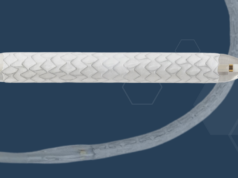
Stefan Müller-Hülsbeck (Ev Luth Diakonissenanstalt zu Flensburg, Flensburg, Germany) presented attendees of the online meeting of the Cardiovascular and Interventional Radiological Society of Europe (CIRSE; 12–15 September, virtual) with an update from the IMPERIAL head-to-head randomised trial comparing the Eluvia drug-eluting stent (DES; Boston Scientific) with the Zilver PTX DES (Cook Medical) for the treatment of femoropopliteal artery lesions. reimbursement
“Through 24 months, there was a significantly lower clinically-driven target lesion revascularisation (CD-TLR) rate for the Eluvia DES than for the Zilver PTX [12.7% vs. 20.1%; p=0.0495],” Müller-Hülsbeck told registrants. An “excellent” primary patency rate was sustained with the Eluvia DES (83% from Kaplan-Meier estimates), and both study devices showed a low mortality rate at 24 months: 7.1% for Eluvia, and 8.3% for Zilver PTX.
In addition, Müller-Hülsbeck reported a significant improvement in mobility and pain/discomfort dimensions of health-related quality of life, sustained over 24 months in both treatment arms.
Cost-effectiveness analysis of the US Medicare system and the German health insurance system showed cost savings; on average, US$1,300 per patient was saved when patients were treated with the Eluvia device in the USA, Müller-Hülsbeck said. “This shows, once again, that when we chose Eluvia, we might achieve a high value when treating our patients with this kind of drug-eluting technology, due to the higher TLR rates we might achieve.”
Moderator Fabrizio Fanelli (Careggi University Hospital, Florence, Italy) stated: “I am very curious about how, still after two years, there is a pretty important gap between the ELUVIA DES and the Zilver PTX”. He queried if Müller-Hülsbeck thought this gap would grow larger in the future, or if he believed that outcomes from using these two devices would become more similar in time.
“That is an excellent question, and it is hard to answer!” Müller-Hülsbeck responded. “Probably the results from [using] both stents could differ, but I think there is also a high probability that the curves in terms of target lesion revascularisation might come closer, so we have to see what will happen in five years.
“The five-year data Michael [Dake] presented [during the same FIRST@CIRSE session] with the Zilver PTX are really outstanding. My personal hope for the patient is that, with Eluvia, we might achieve equal or even slightly better data, but this is just a hope. We will have to see what will happen. Once again, I think that with both technologies, the Eluvia stent and the Zilver PTX, we have options to treat our patients adequately, to provide them with drug-eluting technology.”
Fanelli was in agreement, adding: “This is something everyone is watching with a lot of interest.”
Turning tack to discuss the cost-effective analysis, Fanelli next asked if Müller-Hülsbeck thought this could “push the use of Eluvia, or more generally drug-eluting stents” in the future.
“I think yes,” Müller-Hülsbeck replied, “especially in the USA, because there are some major differences. In Germany, I do not know exactly, because the difference there is slightly lower, but it is my hope—as we want to avoid patients coming back for early target lesion revascularisation—that this kind of technology becomes more accepted by insurance companies for reimbursement. I am mentioning that because, at the moment, especially in Germany, we do not receive any reimbursement if we use drug-eluting technology, either the Zilver PTX or the Eluvia stent.”













